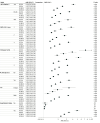Risk of Potentially Preventable Hospitalizations After SARS-CoV-2 Infection
- PMID: 38598237
- PMCID: PMC11007577
- DOI: 10.1001/jamanetworkopen.2024.5786
Risk of Potentially Preventable Hospitalizations After SARS-CoV-2 Infection
Abstract
Importance: Research demonstrates that SARS-CoV-2 infection is associated with increased risk of all-cause hospitalization. However, no prior studies have assessed the association between SARS-CoV-2 and potentially preventable hospitalizations-that is, hospitalizations for conditions that can usually be effectively managed in ambulatory care settings.
Objective: To examine whether SARS-CoV-2 is associated with potentially preventable hospitalization in a nationwide cohort of US veterans.
Design, setting, and participants: This cohort study used an emulated target randomized trial design with monthly sequential trials to compare risk of a potentially preventable hospitalization among veterans with SARS-CoV-2 and matched comparators without SARS-CoV-2. A total of 189 136 US veterans enrolled in the Veterans Health Administration (VHA) who were diagnosed with SARS-CoV-2 between March 1, 2020, and April 30, 2021, and 943 084 matched comparators were included in the analysis. Data were analyzed from May 10, 2023, to January 26, 2024.
Exposure: SARS-CoV-2 infection.
Main outcomes and measures: The primary outcome was a first potentially preventable hospitalization in VHA facilities, VHA-purchased community care, or Medicare fee-for-service care. Extended Cox models were used to examine adjusted hazard ratios (AHRs) of potentially preventable hospitalization among veterans with SARS-CoV-2 and comparators during follow-up periods of 0 to 30, 0 to 90, 0 to 180, and 0 to 365 days. The start of follow-up was defined as the date of each veteran's first positive SARS-CoV-2 diagnosis, with the same index date applied to their matched comparators.
Results: The 1 132 220 participants were predominantly men (89.06%), with a mean (SD) age of 60.3 (16.4) years. Most veterans were of Black (23.44%) or White (69.37%) race. Veterans with SARS-CoV-2 and comparators were well-balanced (standardized mean differences, all <0.100) on observable baseline clinical and sociodemographic characteristics. Overall, 3.10% of veterans (3.81% of those with SARS-CoV-2 and 2.96% of comparators) had a potentially preventable hospitalization during 1-year follow-up. Risk of a potentially preventable hospitalization was greater among veterans with SARS-CoV-2 than comparators in 4 follow-up periods: 0- to 30-day AHR of 3.26 (95% CI, 3.06-3.46); 0- to 90-day AHR of 2.12 (95% CI, 2.03-2.21); 0- to 180-day AHR of 1.69 (95% CI, 1.63-1.75); and 0- to 365-day AHR of 1.44 (95% CI, 1.40-1.48).
Conclusions and relevance: In this cohort study, an increased risk of preventable hospitalization in veterans with SARS-CoV-2, which persisted for at least 1 year after initial infection, highlights the need for research on ways in which SARS-CoV-2 shapes postinfection care needs and engagement with the health system. Solutions are needed to mitigate preventable hospitalization after SARS-CoV-2.
Conflict of interest statement
Figures



References
-
- Agency for Healthcare Research and Quality. Guide to prevention quality indicators: hospital admission for ambulatory care sensitive conditions. Revised November 24, 2004. Accessed October 3, 2023. https://qualityindicators.ahrq.gov/Downloads/Modules/PQI/V21/pqi_guide_r...
-
- Lamberti-Castronuovo A, Valente M, Aleni C, Hubloue I, Ragazzoni L, Barone-Adesi F. Using ambulatory care sensitive conditions to assess primary health care performance during disasters: a systematic review. Int J Environ Res Public Health. 2022;19(15):9193. doi:10.3390/ijerph19159193 - DOI - PMC - PubMed
Publication types
MeSH terms
Grants and funding
LinkOut - more resources
Full Text Sources
Medical
Miscellaneous

